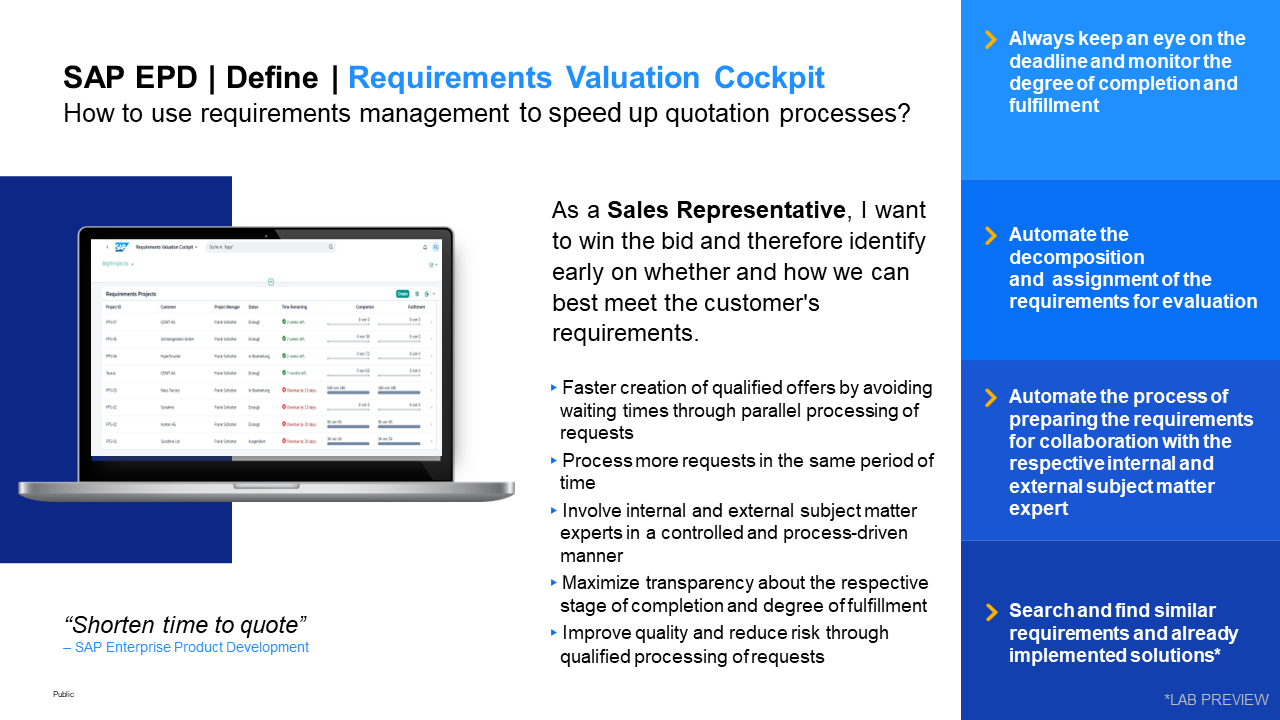
2023-11-21 17:20:44 Author: blogs.sap.com(查看原文) 阅读量:6 收藏
Requirements-Management is commonly associated with the pure product development process. However, this established method can also be used to significantly enhance the evaluation of customer requirements as part of a request-for-quote or request-for-proposal process. Therefore, using Requirements Management as a part of the sales process is not yet widely recognized.
In this blog, I’ll point out several advantages of adapting a system-based approach for the proposal process, which sales reps should think about.
Never miss a deadline anymore!
Typically, within a bidding process, the customer requires a highly customized solution. The vendor must therefore ensure, that he is able to fulfill the majority of the customer’s requirements. Only then the vendor has a chance to win the bid. The more complex the requirements are, the more difficult they are to evaluate, and the longer the quotation process takes. In some cases, this leads to the inability to meet the deadlines for submitting the quote which means that potential orders are lost.
As I mention in a previous post customer requirements go through many individual steps and checks during a typical request for proposal or request for quote process.
- The required subject matter experts typically cover the entire value chain of the company, from development over manufacturing and assembly to service.
- Tasks are assigned and distributed to the responsibilities and also to the involved suppliers.
- Interdisciplinary feasibility studies, both functional and non-functional, are carried out
- Order-specific components are conceptually elaborated, and production capability is verified and calculated.
- Not only the customer’s requirements, also the company’s internal guidelines as well as legal requirements must be considered.
- Results and approvals are obtained, across many departments and often across company and national boundaries
Requirements-Management for the quotation process
The very simple question is why many companies don’t use requirements management to support this process instead of spreadsheets?
- Perhaps because typical requirements management systems for the development process are not optimally designed for bidding and lack functions?
- Or perhaps the users are too busy with administrative tasks to use a system for requirements management and the results are not satisfactory?
Most of the questions can be answered with “yes” and that was the motivation for us to develop our new software, the Requirements Valuation Cockpit (RVC). RVC is a Add-on for SAP EPD Requirements Mangement and makes it possible to evaluate complex customer requirements across several departments in a coordinated and process-driven manner and to support the creation of qualified offers much faster than before.

Requirements Valuation Cockpit at a glance
What makes RVC special is that it leverages the proven capabilities of SAP Enterprise Product Development’s Capability Requirements Engineering and extends them with useful features.

Requirements Valuation Cockpit
RVC provides functionality to improve the handling of complex RFQ/RFP processes in three main areas.
- The time is critical and it’s hard to keep an overview about a distributed valuation though colleagues and suppliers. Therefore, the Cockpit lets you always keep an eye on time remaining and the completion and fulfillment of the valuated requirements.
- RVC addresses the processing of complex RFQ/RFP processes and that means that a lot of different requirements must be valuated through a lot of different experts. But who exactly is responsible for the valuation of each single requirement? Among other questions, this one is answered by the Decomposer, which searches for keywords in the requirements description and assigns the responsible department to the requirement.
- After assigning the responsible department for valuation, the requirements have to be shared with the departments. Sometimes the departments need to share some of them with their external suppliers. The Collaboration Handler automates the creation of collaborations, the invitation of colleagues, suppliers or the customer and sharing the assigned requirements.
Long story short: The above-mentioned functionalities of RVC significantly reduce the effort required to valuate customer requirements compared to traditional methods.
Are you ready to discover more?
I have made you curious and you want to take the next steps with CENIT? I look forward to hearing from you.
In the meantime, visit RVC at the SAP STORE for more insights or download the product flyer and product data sheet.
And if you want to know more about SAP EPD Requirements Management itself, this step-by-step guide by Lisa Schmitt will give you a better understanding of how you can use requirements management in your product development processes.
About the Author
Frank Schlotter is Vice President Business Development SAP Solutions at CENIT AG. He has more than 30 years of experience in industrial business processes and more than 20 years of experience with SAP solutions.
When he is not working on the realisation of new business ideas or new products, he works for his clients as an executive consultant, helping them to design and implement end-to-end processes from design to operation or idea to market.
Follow him in the SAP Community SAP Community or on LinkedIn.
如有侵权请联系:admin#unsafe.sh